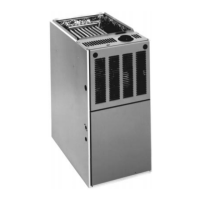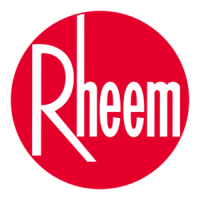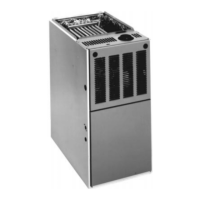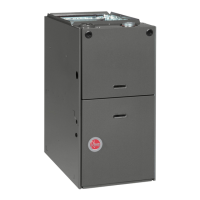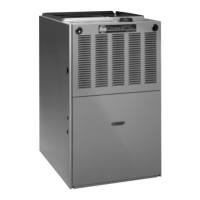FIGURE 10
OUTSIDE AIR USING A HORIZONTAL INLET & OUTLET
FIGURE 11
COMBUSTION AIR FITTING – OPTIONAL ATTIC COMBUSTION AIR PULL, RGPE ONLY
B: Method 3, RGPE only
For the optimum in quiet operation, attic
air may be brought directly to the fur-
nace.
IMPORTANT: In applications using
Method 3 for combustion air, the attic
must be ventilated by gable or soffit
vents. See Figure 8.
It is not required to provide any per-
manent openings as described in
Method 1
or Method 2.
COMBUSTION AIR INTAKES CAN-
NOT BE TERMINATED OUTSIDE.
DOING SO CAN CAUSE IMPROPER
OPERATION OF THE FURNACE
If attic combustion air is used, the inlet
air opening at the furnace must be pro-
tected from accidental blockage. Install
a 90° elbow pointing horizontally at the
top of inlet air pipe. See Figure 11
(maximum of 2, 22
1
⁄2°, 45° or 90°
elbows, allowed).
INCLUDING
HORIZONTAL DIRECTION
ATTACH A 90° ELBOW TO TOP INLET AIR
OPENING TO PREVENT ACCIDENTAL BLOCKAGE
OF INTAKE OPENING.
NOTE: Maximum length of pipe that
may be used for combustion air is
10 feet with two elbows. Lengths of
more than 10 feet can result in nui-
sance pressure switch trips.
CAUTION
!
PVC
ELBOW
#8 SCREWS
#8 SCREW
METAL FLUE PIPE ONLY
10 FT. MAX.
12" MIN. FROM
TOP OF INSULATION
6" MINIMUM
CLEARANCE
PVC
COUPLER
EXHAUST
ATTIC SPACE
INDOOR SPACE
INSULATION
CAUTION
!
USE OF SHEET METAL
AIR INTAKE PIPE
INSTEAD OF PVC MAY
RESULT IN NOISE ISSUES.
NOTE: PREDRILL HOLES FOR SCREWS TO PREVENT CRACKING.
15
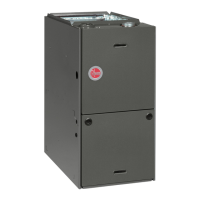
